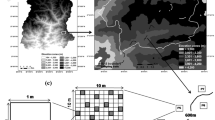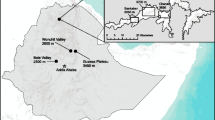Abstract
Many mammalian herbivores show a temporal diet variation between graminoid-dominated and browse-dominated diets. We determined the causes of such a diet shift and its implications for conservation of a medium-sized ungulate—the bharal Pseudois nayaur. Past studies show that the bharal diet is dominated by graminoids (>80%) during summer, but the contribution of graminoids declines to about 50% in winter. We tested the predictions generated by two alternative hypotheses explaining the decline: low graminoid availability during winter causes bharal to include browse in their diet; bharal include browse, with relatively higher nutritional quality, in their diet to compensate for the poor quality of graminoids during winter. We measured winter graminoid availability in areas with no livestock grazing, areas with relatively moderate livestock grazing, and those with intense livestock grazing pressures. The chemical composition of plants contributing to the bharal diet was analysed. The bharal diet was quantified through signs of feeding on vegetation at feeding locations. Population structures of bharal populations were recorded using a total count method. Graminoid availability was highest in areas without livestock grazing, followed by areas with moderate and intense livestock grazing. The bharal diet was dominated by graminoids (73%) in areas with highest graminoid availability. Graminoid contribution to the bharal diet declined monotonically (50, 36%) with a decline in graminoid availability. Bharal young to female ratio was 3 times higher in areas with high graminoid availability than areas with low graminoid availability. The composition of the bharal winter diet was governed predominantly by the availability of graminoids in the rangelands. Our results suggest that bharal include more browse in their diet during winter due to competition from livestock for graminoids. Since livestock grazing reduces graminoid availability, creation of livestock-free areas is necessary for the conservation of grazing species such as the bharal and its predators including the endangered snow leopard in the Trans-Himalaya.






Similar content being viewed by others
References
AOAC (1990) Official methods of analysis, 15th edn. Association of Official Analytical Chemists, Arlington
Aswal BS, Mehrotra BN (1994) Flora of Lahaul-Spiti. Bishen Singh Mahendra Pal Singh, Dehradun
Aunapuu M, Dhalgren J, Oksanen T, Grellman D, Oksanen L, Olofsson J, Rammul U, Scheider M, Johansen B, Hygen HO (2008) Spatial patterns and dynamic responses of arctic food webs corroborate the exploitation ecosystems hypothesis (EEH). Am Nat 171:249–262
Bodmer RE (1990) Responses of ungulates to seasonal inundations in the Amazon floodplain. J Trop Ecol 6:191–201
Brown DT, Doucet GT (1991) Temporal changes in winter diet selection by white-tailed deer in a northern deer yard. J Wildl Manage 55:361–376
Christianson D, Creel S (2009) Effects of grass and browse consumption on the winter mass dynamics of elk. Oecologia 158:603–613
Clutton-Brock TH, Major M, Albon SD, Guinness FE (1987) Early development and population dynamics in red deer. I. Density-dependent effects on juvenile survival. J Anim Ecol 56:53–67
Crete M, Huot J (1993) Regulation of a large herd of migratory caribou: summer nutrition affects calf growth and body reserves of dams. Can J Zool 71:2291–2296
Gaillard J, Festa-Bianchet M, Yoccoz NG (1998) Population dynamics of large herbivores: variable recruitment with constant adult survival. Trees 13:58–63
Goodson NJ, Stevens DR, Bailey JA (1991) Effects of snow on foraging ecology and nutrition of bighorn sheep. J Wildl Manage 55:214–222
Gordon IJ (2003) Browsing and grazing ruminants: are they different beasts? For Ecol Manage 181:13–21
Hairston NG, Smith FE, Slobodkin LB (1960) Community structure, population control, and competition. Am Nat 94:421–425
Hofmann RR (1989) Evolutionary steps of ecophysiological adaptation and diversification of ruminants: a comparative view of their digestive system. Oecologia 78:443–457
Hulbert IAR, Andersen R (2001) Food competition between a large ruminant and a small hindgut fermentor: the case of the roe deer and mountain hare. Oecologia 128:499–508
Hulbert IAR, Iason GR, Mayes RW (2001) The flexibility of an intermediate feeder: dietary selection by mountain hares measured using faecal n-alkanes. Oecologia 129:197–205
Iason GR, Van Wieren SE (1999) Digestive and ingestive adaptations of mammalian herbivores to low-quality forage. In: Olf H, Brown VK, Brent R (eds) Herbivores: between plants and predators. Proceedings of the Symposium of the British Ecological Society. Blackwell, Oxford, pp 337–369
Illius AW, Gordon IJ (1999) Scaling up from functional response to numerical response in vertebrate herbivores. In: Olf H, Brown VK, Brent R (eds) Herbivores: between plants and predators. Proceedings of the Symposium of the British Ecological Society. Blackwell, Oxford, pp 397–427
Krebs CJ (1989) Ecological methodology. Harper & Row, New York
Loison A, Langvatn R, Solberg EJ (1999) Body mass and winter mortality in red deer calves: disentangling sex and climatic effects. Ecography 22:20–30
Mattson WJ (1980) Herbivory in relation to plant nitrogen content. Annu Rev Ecol Syst 11:119–161
Mishra C (2001) High altitude survival: conflicts between pastoralism and wildlife in the Trans-Himalaya. Ph.D. thesis, Wageningen University, Wageningen
Mishra C, Prins HHT, Van Wieren SE (2001) Overstocking in the Trans-Himalayan rangelands of India. Environ Conserv 28:279–283
Mishra C, Van Wieren S, Ketner P, Heitkonig IMA, Prins HHT (2004) Competition between domestic livestock and wild bharal Pseudois nayaur in the Indian Trans-Himalaya. J Appl Ecol 41:344–354
Morgantini LE, Hudson RJ (1985) Changes in diets of wapiti during a hunting season. J Range Manage 38:77–79
Murdoch WW (1966) “Community structure, population control, and competition”—a critique. Am Nat 100:219–221
Robbins CT, Hagerman AE, Hjelijord O, Baker DL (1987) Role of tannins in defending plants against ruminants: reduction in protein availability. Ecology 68:98–107
Robbins CT, Spalinger DE, Van Hoven W (1995) Adaptation to ruminant browse and grass diet: are anatomical-based browser-grazer interpretations valid? Oecologia 103:208–213
Short HL (1971) Forage digestibility and diet of deer on southern upland range. J Wildl Manage 35:698–706
Shrestha R, Wegge P, Koirala RA (2005) Summer diets of wild and domestic ungulates in Nepal Himalaya. J Zool 266:111–119
Tempel Cvd, Vriji Md (2008) Cranial and appendicular morphologies functionally related to feeding type and habitat of Trans-Himalayan Caprinae. M.Sc. dissertation, Wageningen Agriculture University, Wageningen
Turchin P, Batzli GO (2001) Availability of food and the population dynamics of arvicoline rodents. Ecology 82:1521–1534
Van Soest PJ (1982) Nutritional ecology of the ruminant. O & B, Corvallis
Van Soest PJ, Robertson JB, Lewis BA (1991) Method for dietary fibre, neutral detergent fibre and non starch polysaccharides in relation to animal nutrition. J Dairy Sci 74:3583–3597
Van Wieren SE (1996) Digestive strategy in ruminants and nonruminants. Ph.D. dissertation, Wagningen Agriculture University, Wageningen
Vanderploeg HA, Scavia D (1979) Two electivity indices for feeding with special reference to zooplankton grazing. J Fish Res Bd Can 36:362–365
Wallace LL, Turner MG, Romme WH, O’Neil RV, Wu Yegang (1995) Scale of heterogeneity of forage production and winter foraging by elk and bison. Landscape Ecol 10:75–83
Zhong W, Wang G, Zhou Q, Wan X, Wang G (2008) Effects of winter food availability on the abundance of Daurian pikas (Ochotona dauurica) in Inner Mongolian grasslands. J Arid Environ 72:1383–1387
Acknowledgments
This study was made possible by a grant from the Snow Leopard Network. Additional support was given by the Wildlife Conservation Society-India Program and Nature Conservation Foundation, the Whitley Fund for Nature, the Ford Foundation, and the Nadathur Conservation Trust. The National Centre for Biological Sciences provided infrastructure. We thank Dr Ajith Kumar, Dr Anindya Sinha, Dr Jagdish Krishnaswamy, Sumanta Bagchi and Devcharan Jathanna for their suggestions; Kalzang Pulzor, Tenzin Takpa, Tandup Dorje, Kalzang Gurmet, Tenzin Thilley and Dorje Tsewang, for their invaluable help with field work. We are grateful to Shri Vinay Tandon of the Himachal Pradesh Forest Department for permission to carry out field work.
Author information
Authors and Affiliations
Corresponding author
Additional information
Communicated by Janne Sundell.
Rights and permissions
About this article
Cite this article
Suryawanshi, K.R., Bhatnagar, Y.V. & Mishra, C. Why should a grazer browse? Livestock impact on winter resource use by bharal Pseudois nayaur . Oecologia 162, 453–462 (2010). https://doi.org/10.1007/s00442-009-1467-x
Received:
Accepted:
Published:
Issue Date:
DOI: https://doi.org/10.1007/s00442-009-1467-x




